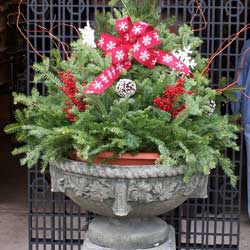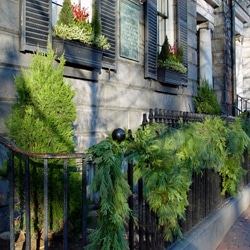Container Gardening isn’t over…it has just changed seasons! (Winter Planter Ideas)
Do you miss the vibrancy of your flowerbeds and your landscape’s rich, lush colors once winter sets in? With warm-weather pots, window boxes, and hanging baskets already in place, decorating the outside of your house this winter will be a cinch!
- Use only containers that are winter-safe. Porous pots, like terra cotta, are not a good choice as they tend to crack when they freeze. Better choices include cast iron or aluminum urns, fiberglass or foam containers, cocoa-lined wire hanging baskets, and troughs. For a truly holiday look, consider containers with red-and-green coloration or other holiday hues, or look for whimsical holiday-themed designs.
- Use the soil that is already in your containers. Remove just the tops from your previous plantings, allowing their roots to remain in the soil as an anchor for your winter arrangement. OASIS Floral foam is another good choice that works well for smaller outdoor arrangements like those in hanging baskets. You may also need some plant or gardening pins to help keep your arrangement in place and secure.
- Begin by adding greens to your container (note: your greens will last longer if soaked in Wilt-Pruf for 24 hours before using). Cut branches to the desired length and remove all green needles from the portion that will be inserted into the soil. Create a dense base for your arrangement using either white pine or spruce. Consider allowing some boughs to trail over the edge of the arrangement for more visual interest, or mix up different types of greens for interesting texture.
- Create a focal point for your arrangement with the addition of a few tall branches of curly willow, Harry Lauder’s Walking Stick, red twig dogwood, or white-painted birch. Position these taller elements near the back of the arrangement to allow more room for additional plants and decorative items. To add more magic to the arrangement, consider painting taller branches gold or silver.
- Incorporate more winter-themed plants into the arrangement to include additional color and texture. Magnolia leaves, holly, incense cedar, winterberry, China berry, pepper berry, protea, eucalyptus, or other decorative branches and berries are all top choices. Go for a lush, tiered look for the best effect.
- To bring your arrangement to life add mini white or colored lights, desired ornaments, and weather-proof ribbons. For a more whimsical look, consider garlands, candy canes, cranberry strings, or even a fairy gingerbread house. Remove these when the holiday season ends and leave the arrangement intact until it is time for spring planting.
- You might spruce up around the pot to bring even more notice to your arrangement. Consider a ribbon around the pot, or add light-up gift boxes or wrapped boxes around the pot to create a larger focus.
With just a few steps, the outdoor containers you enjoy in spring, summer, and fall can continue to be lovely accents for holiday and winter decoration.
All vegetables need calcium for healthy development. When tomatoes, peppers, melons, and eggplant can’t get enough, the tissues on the blossom end of the fruit break down. By testing your soil to determine its pH and calcium content, regularly watering, and curbing fertilizer use, your susceptible veggies should be free of BER.
The best prevention occurs before planting. The soil pH determines the amount of calcium available to a plant. At lower pH levels, less calcium is available for the plant to absorb because it becomes chemically tied up in the soil. Most vegetables grow well in soils with a pH of 6.2-6.8. However, vegetables susceptible to BER require a pH of 6.5-6.8, where more calcium is available and it can be more easily absorbed, especially during rapid growth and fruiting periods. If the pH is lower than 6.5, the crop is likely to develop BER. This can also occur when the pH is correct, but the soil contains an insufficient amount of calcium.
Water fluctuations and excessive fertilizer also affect nutrient absorption. A plant requires water to absorb nutrients. If no water is present, no nutrients can be absorbed, and in addition to blossom end rot, plants may be small and weak as well as more susceptible to other pests, diseases and deficiencies.
Additionally, too much fertilizer can cause a plant to grow so quickly that the nutrient uptake cannot meet the demands of growth, leading to BER. In these cases, the plants grow so rapidly and develop produce so quickly that there isn’t time for the proper nutrient balance to be absorbed, including the right amount of calcium. Because of this accelerated growth and insufficient nutrition for the growth pace, plants will be more susceptible to blossom end rot.
Unfortunately, simply adding calcium to the soil will not stop BER this year, but it can help your soil become better conditioned for next year. However, we do carry several products to help with this year’s crop as well. Easy-to-use calcium sprays can save much of this year’s crop of tomatoes or other vulnerable produce. Stop in, and our knowledgeable staff will help you find the best product for your situation, as well as tips on improving your soil’s pH levels, calcium content, moisture retention, and overall nutrition so blossom end rot is never a problem in your garden again.














